Foreword 前言
1Scope 1条,适用范围
2References2个参考
3Definitions and abbreviations3定义和缩写
3.1Definitions3.1定义
3.2Abbreviations3.2缩写
4Architecture model and concepts4架构模型和概念
4.1General concepts4.1一般概念
4.2Architecture reference model4.2体系结构参考模型
4.2.1General4.2.1一般
4.2.2Network Functions and entities4.2.2网络功能和实体
4.2.3Non-roaming reference architecture4.2.3非漫游
4.2.4Roaming reference architectures4.2.4漫游参考体系
4.2.5Data Storage architectures4.2.5数据存储体系结构
4.2.6Service-based interfaces4.2.6基于服务的接口
4.2.7Reference points
4.2.8Support of non-3GPP access4.2.8支持非3GPP接入
4.2.8.1General Concepts to Support Non-3GPP Acces
4.2.8.2Architecture Reference Model for Non-3GPP
4.2.8.2.1Non-roaming Architecture for Non-3GPP Ac
4.2.8.2.2LBO Roaming Architecture for Non-3GPP Ac
4.2.8.2.3Home-routed Roaming Architecture for Non
4.2.8.2.4LBO Roaming Architecture for Non-3GPP Ac
4.2.8.2.5Home-routed Roaming Architecture for Non
4.2.8.3Non-3GPP Access Reference Points4.2.8.3非
4.2.9Network Analytics architecture4.2.9网络分析体系结
4.3Interworking with EPC4.3与EPC的互通
4.3.1Non-roaming architecture4.3.1非漫游架构
4.3.2Roaming architecture4.3.2漫游架构
4.3.3Interworking between 5GC via non-3GPP access
4.3.3.1Non-roaming architecture4.3.3.1非漫游架构
4.3.3.2Roaming architecture4.3.3.2漫游架构
4.3.4Interworking between ePDG connected to EPC a
4.3.4.1Non-roaming architecture4.3.4.1非漫游架构
4.3.4.2Roaming architectures4.3.4.2漫游架构
4.4Specific services4.4特定服务
4.4.1Public Warning System4.4.1公共预警系统
4.4.2SMS over NAS4.4.2通过NAS的SMS
4.4.2.1Architecture to support SMS over NAS4.4.
4.4.2.2Reference point to support SMS over NAS4
4.4.2.3Service based interface to support SMS ove
4.4.3IMS support4.4.3 IMS支持
4.4.4Location services4.4.4位置服务
4.4.4.1Architecture to support Location Services
4.4.4.2Reference point to support Location Servic
4.4.4.3Service Based Interfaces to support Locati
4.4.5Application Triggering Services4.4.5应用程序触发
5High level features
5.1General5.1一般
5.2Network Access Control5.2网络访问控制
5.2.1General5.2.1一般
5.2.2Network selection5.2.2网络选择
5.2.3Identification and authentication5.2.3识别和认
5.2.4Authorisation5.2.4授权
5.2.5Access control and barring5.2.5访问控制和禁止
5.2.6Policy control5.2.6政策控制
5.2.7Lawful Interception5.2.7合法拦截
5.3Registration and Connection Management5.3注册和
5.3.1General5.3.1一般
5.3.2Registration Management5.3.2注册管理
5.3.2.1General5.3.2.1一般
5.3.2.25GS Registration Management states5.3.2.
5.3.2.2.1General5.3.2.2.1一般
5.3.2.2.2RM-DEREGISTERED state5.3.2.2.2 RM注销状态
5.3.2.2.3RM-REGISTERED state5.3.2.2.3 RM-REGIST
5.3.2.2.45GS Registration Management State models
5.3.2.3Registration Area management5.3.2.3注册区域管
5.3.2.4Support of a UE registered over both 3GPP
5.3.3Connection Management5.3.3连接管理
5.3.3.1General5.3.3.1一般
5.3.3.25GS Connection Management states5.3.3.2
5.3.3.2.1General5.3.3.2.1一般
5.3.3.2.2CM-IDLE state5.3.3.2.2 CM-IDLE状态
5.3.3.2.3CM-CONNECTED state5.3.3.2.3 CM-CONNECT
5.3.3.2.45GS Connection Management State models
5.3.3.2.5CM-CONNECTED with RRC Inactive state5.
5.3.3.3NAS signalling connection management5.3.
5.3.3.3.1General5.3.3.3.1一般
5.3.3.3.2NAS signalling connection establishment
5.3.3.3.3NAS signalling connection Release5.3.3
5.3.3.4Support of a UE connected over both 3GPP a
5.3.4UE Mobility5.3.4 UE移动性
5.3.4.1Mobility Restrictions5.3.4.1移动限制
5.3.4.1.1General5.3.4.1.1一般
5.3.4.1.2Management of Service Area Restrictions
5.3.4.2Mobility Pattern5.3.4.2移动模式
5.3.4.3Radio Resource Management functions5.3.4
5.3.4.4UE mobility event notification5.3.4.4 UE
5.43GPP access specific aspects5.4 3GPP接入特定方面
5.4.1UE reachability in CM-IDLE5.4.1 CM-IDLE中的U
5.4.1.1General5.4.1.1一般
5.4.1.2UE reachability allowing mobile terminated
5.4.1.3Mobile Initiated Connection Only (MICO) mo
5.4.2UE reachability in CM-CONNECTED5.4.2 CM-CO
5.4.3Paging strategy handling5.4.3分页策略处理
5.4.3.1General5.4.3.1一般
5.4.3.2Paging Policy Differentiation5.4.3.2分页策略
5.4.3.3Paging Priority5.4.3.3寻呼优先级
5.4.4UE Radio Capability handling5.4.4 UE无线电能力处
5.4.4.1UE radio capability information storage in
5.4.4.2Void5.4.4.2虚空
5.4.4.2aUE Radio Capability Match Request5.4.4.
5.4.4.3Paging assistance information5.4.4.3寻呼辅助
5.4.4aUE MM Core Network Capability handling5.4
5.4.4bUE 5GSM Core Network Capability handling5
5.4.5DRX (Discontinuous Reception) framework5.4
5.4.6Core Network assistance information for RAN
5.4.6.1General5.4.6.1一般
5.4.6.2Core Network assisted RAN parameters tunin
5.4.6.3Core Network assisted RAN paging informati
5.4.7NG-RAN location reporting5.4.7 NG-RAN位置报告
5.5Non-3GPP access specific aspects5.5非3GPP接入特定
5.5.1Registration Management5.5.1注册管理
5.5.2Connection Management5.5.2连接管理
5.5.3UE Reachability5.5.3 UE可达性
5.5.3.1UE reachability in CM-IDLE5.5.3.1 CM-IDL
5.5.3.2UE reachability in CM-CONNECTED5.5.3.2 C
5.6Session Management5.6会话管理
5.6.1Overview5.6.1概述
5.6.2Interaction between AMF and SMF5.6.2 AMF和S
5.6.3Roaming5.6.3漫游
5.6.4Single PDU Session with multiple PDU Session
5.6.4.1General5.6.4.1一般
5.6.4.2Usage of an UL Classifier for a PDU Sessio
5.6.4.3Usage of IPv6 multi-homing for a PDU Sessi
5.6.5Support for Local Area Data Network5.6.5支持
5.6.6Secondary authentication/authorization by a
5.6.7Application Function influence on traffic ro
5.6.8Selective activation and deactivation of UP
5.6.9Session and Service Continuity5.6.9会话和服务连续
5.6.9.1General5.6.9.1一般
5.6.9.2SSC mode5.6.9.2 SSC模式
5.6.9.2.1SSC Mode 15.6.9.2.1 SSC模式1
5.6.9.2.2SSC Mode 25.6.9.2.2 SSC模式2
5.6.9.2.3SSC Mode 35.6.9.2.3 SSC模式3
5.6.9.3SSC mode selection5.6.9.3 SSC模式选择
5.6.10Specific aspects of different PDU Session t
5.6.10.1Support of IP PDU Session type5.6.10.1支
5.6.10.2Support of Ethernet PDU Session type5.6
5.6.10.3Support of Unstructured PDU Session type
5.6.11UE presence in Area of Interest reporting u
5.6.12Use of Network Instance5.6.12使用网络实例
5.7QoS model5.7 QoS模型
5.7.1General Overview5.7.1总体概述
5.7.1.1QoS Flow5.7.1.1 QoS流程
5.7.1.2QoS Profile5.7.1.2 QoS配置文件
5.7.1.3Control of QoS Flows5.7.1.3 QoS流量的控制
5.7.1.4QoS Rules5.7.1.4 QoS规则
5.7.1.5QoS Flow mapping5.7.1.5 QoS流映射
5.7.1.6DL traffic5.7.1.6 DL流量
5.7.1.7UL Traffic5.7.1.7 UL流量
5.7.1.8AMBR/MFBR enforcement and rate limitation
5.7.1.9Precedence Value5.7.1.9优先值
5.7.25G QoS Parameters5.7.2 5G QoS参数
5.7.2.15QI5.7.2.1 5QI
5.7.2.2ARP5.7.2.2 ARP
5.7.2.3RQA5.7.2.3 RQA
5.7.2.4Notification control5.7.2.4通知控制
5.7.2.5Flow Bit Rates5.7.2.5流量比特率
5.7.2.6Aggregate Bit Rates5.7.2.6总比特率
5.7.2.7Default values5.7.2.7默认值
5.7.2.8Maximum Packet Loss Rate5.7.2.8最大分组丢失率
5.7.35G QoS characteristics5.7.3 5G QoS特性
5.7.3.1General5.7.3.1一般
5.7.3.2Resource Type5.7.3.2资源类型
5.7.3.3Priority Level5.7.3.3优先级
5.7.3.4Packet Delay Budget5.7.3.4分组延迟预算
5.7.3.5Packet Error Rate5.7.3.5分组错误率
5.7.3.6Averaging Window5.7.3.6平均窗口
5.7.3.7Maximum Data Burst Volume5.7.3.7最大数据突发量
5.7.4Standardized 5QI to QoS characteristics mapp
5.7.5Reflective QoS5.7.5反射式QoS
5.7.5.1General5.7.5.1一般
5.7.5.2UE Derived QoS Rule5.7.5.2 UE导出的QoS规则
5.7.5.3Reflective QoS Control5.7.5.3反射式QoS控制
5.7.6Packet Filter Set5.7.6数据包过滤器集
5.7.6.1General5.7.6.1一般
5.7.6.2IP Packet Filter Set5.7.6.2 IP数据包过滤器集
5.7.6.3Ethernet Packet Filter Set5.7.6.3以太网分组过滤
5.8User Plane Management5.8用户平面管理
5.8.1General5.8.1一般
5.8.2Functional Description5.8.2功能描述
5.8.2.1General5.8.2.1一般
5.8.2.2UE IP Address Management5.8.2.2 UE IP地址管
5.8.2.2.1General5.8.2.2.1一般
5.8.2.2.2Routing rules configuration5.8.2.2.2路由
5.8.2.2.3The procedure of Stateless IPv6 Address
5.8.2.3Management of CN Tunnel Info5.8.2.3 CN隧道
5.8.2.3.1General5.8.2.3.1一般
5.8.2.3.2Management of CN Tunnel Info in the SMF
5.8.2.3.3Management of CN Tunnel Info in the UPF
5.8.2.4Traffic Detection5.8.2.4流量检测
5.8.2.4.1General5.8.2.4.1一般
5.8.2.4.2Traffic Detection Information5.8.2.4.2
5.8.2.5Control of User Plane Forwarding5.8.2.5控
5.8.2.6Charging and Usage Monitoring Handling5.
5.8.2.6.1General5.8.2.6.1一般
5.8.2.6.2Activation of Usage Reporting in UPF5.
5.8.2.6.3Reporting of Usage Information towards S
5.8.2.7PDU Session and QoS Flow Policing5.8.2.7
5.8.2.8PCC Related Functions5.8.2.8 PCC相关功能
5.8.2.8.1Activation/Deactivation of predefined PC
5.8.2.8.2Enforcement of Dynamic PCC Rules5.8.2.
5.8.2.8.3Redirection5.8.2.8.3重定向
5.8.2.8.4Support of PFD Management5.8.2.8.4支持PF
5.8.2.9Functionality of Sending of "End marker"
5.8.2.9.0Introduction5.8.2.9.0简介
5.8.2.9.1UPF Constructing the "End marker" Packet
5.8.2.9.2SMF Constructing the "End marker" Packet
5.8.2.10UP Tunnel Management5.8.2.10 UP隧道管理
5.8.2.11Parameters for N4 session management5.8
5.8.2.11.1General5.8.2.11.1一般
5.8.2.11.2N4 Session Context5.8.2.11.2 N4会话上下文
5.8.2.11.3Packet Detection Rule5.8.2.11.3分组检测规则
5.8.2.11.4QoS Enforcement Rule5.8.2.11.4 QoS执行规
5.8.2.11.5Usage Reporting Rule5.8.2.11.5使用报告规则
5.8.2.11.6Forwarding Action Rule5.8.2.11.6转发行为规
5.8.2.11.7Usage Report generated by UPF5.8.2.11
5.8.2.12Reporting of the UE MAC addresses used in
5.8.3Explicit Buffer Management5.8.3显式缓冲区管理
5.8.3.1General5.8.3.1一般
5.8.3.2Buffering at UPF5.8.3.2 UPF缓冲
5.8.3.3Buffering at SMF5.8.3.3 SMF缓冲
5.8.4SMF Pause of Charging5.8.4 SMF暂停充电
5.9Identifiers5.9标识符
5.9.1General5.9.1一般
5.9.2Subscription Permanent Identifier5.9.2签约永久
5.9.2aSubscription Concealed Identifier5.9.2a订阅
5.9.3Permanent Equipment Identifier5.9.3永久设备标识符
5.9.45G Globally Unique Temporary Identifier5.9
5.9.5AMF Name5.9.5 AMF名称
5.9.6Data Network Name (DNN)5.9.6数据网络名称(DNN)
5.9.7Internal-Group Identifier5.9.7内部组标识符
5.9.8Generic Public Subscription Identifier5.9.
5.9.9AMF UE NGAP ID5.9.9 AMF UE NGAP ID
5.10Security aspects5.10安全方面
5.10.1General5.10.1概述
5.10.2Security Model for non-3GPP access5.10.2非
5.10.2.1Signalling Security5.10.2.1信令安全
5.10.3PDU Session User Plane Security5.10.3 PDU
5.11Support for Dual Connectivity, Multi-Connecti
5.11.1Support for Dual Connectivity5.11.1支持双连接
5.12Charging5.12充电
5.13Support for Edge Computing5.13支持边缘计算
5.14Policy Control5.14政策控制
5.15Network slicing5.15网络切片
5.15.1General5.15.1一般
5.15.2Identification and selection of a Network S
5.15.2.1General5.15.2.1一般
5.15.2.2Standardised SST values5.15.2.2标准化SST值
5.15.3Subscription aspects5.15.3订购方面
5.15.4UE NSSAI configuration and NSSAI storage as
5.15.4.1General5.15.4.1一般
5.15.4.1.1UE Network Slice configuration5.15.4.
5.15.4.1.2Mapping of S-NSSAIs values in the Allow
5.15.4.2Update of UE Network Slice configuration
5.15.5Detailed Operation Overview5.15.5详细操作概述
5.15.5.1General5.15.5.1一般
5.15.5.2Selection of a Serving AMF supporting the
5.15.5.2.1Registration to a set of Network Slices
5.15.5.2.2Modification of the Set of Network Slic
5.15.5.2.3AMF Re-allocation due to Network Slice(
5.15.5.3Establishing a PDU Session in a Network S
5.15.6Network Slicing Support for Roaming5.15.6
5.15.7Network slicing and Interworking with EPS
5.15.7.1General5.15.7.1一般
5.15.7.2Idle mode aspects5.15.7.2空闲模式方面
5.15.7.3Connected mode aspects5.15.7.3连接模式方面
5.15.8Configuration of Network Slice availability
5.16Support for specific services5.16支持特定服务
5.16.1Public Warning System5.16.1公共预警系统
5.16.2SMS over NAS5.16.2通过NAS的SMS
5.16.2.1General一般5.16.2.1
5.16.2.2SMS over NAS transport5.16.2.2通过NAS传输的S
5.16.3IMS support5.16.3 IMS支持
5.16.3.1General5.16.3.1一般
5.16.3.2IMS voice over PS Session Supported Indic
5.16.3.2aIMS voice over PS Session Supported Indi
5.16.3.3Homogeneous support for IMS voice over PS
5.16.3.4P-CSCF address delivery5.16.3.4 P-CSCF地
5.16.3.5Domain selection for UE originating sessi
5.16.3.6Terminating domain selection for IMS voic
5.16.3.7UE's usage setting5.16.3.7 UE的使用设置
5.16.3.8Domain and Access Selection for UE origin
5.16.3.8.1UE originating SMS for IMS Capable UEs
5.16.3.8.2Access Selection for SMS over NAS5.16
5.16.3.9SMF support for P-CSCF restoration proced
5.16.3.10IMS Voice Service via EPS Fallback or RA
5.16.4Emergency Services5.16.4紧急服务
5.16.4.1Introduction5.16.4.1简介
5.16.4.2Architecture Reference Model for Emergenc
5.16.4.3Mobility Restrictions and Access Restrict
5.16.4.4Reachability Management5.16.4.4可达性管理
5.16.4.5SMF and UPF selection function for Emerge
5.16.4.6QoS for Emergency Services5.16.4.6紧急服务的
5.16.4.7PCC for Emergency Services5.16.4.7用于紧急服
5.16.4.8IP Address Allocation5.16.4.8 IP地址分配
5.16.4.9Handling of PDU Sessions for Emergency Se
5.16.4.10Support of eCall Only Mode5.16.4.10仅支持
5.16.4.11Emergency Services Fallback5.16.4.11紧急
5.16.5Multimedia Priority Services5.16.5多媒体优先服务
5.16.6Mission Critical Services5.16.6关键任务服务
5.17Interworking and Migration5.17互通和迁移
5.17.1Support for Migration from EPC to 5GC5.17
5.17.1.1General5.17.1.1一般
5.17.1.2User Plane management to support interwor
5.17.2Interworking with EPC5.17.2与EPC的互通
5.17.2.1General5.17.2.1一般
5.17.2.2Interworking Procedures with N26 interfac
5.17.2.2.1General5.17.2.2.1一般
5.17.2.2.2Mobility for UEs in single-registration
5.17.2.3Interworking Procedures without N26 inter
5.17.2.3.1General5.17.2.3.1一般
5.17.2.3.2Mobility for UEs in single-registration
5.17.2.3.3Mobility for UEs in dual-registration m
5.17.2.3.4Redirection for UEs in connected state
5.17.2.4Mobility between 5GS and GERAN/UTRAN5.1
5.17.3Interworking with EPC in presence of Non-3G
5.17.4Network sharing support and interworking be
5.18Network Sharing5.18网络共享
5.18.1General concepts5.18.1一般概念
5.18.2Broadcast system information for network sh
5.18.2aPLMN list handling for network sharing5.
5.18.3Network selection by the UE
5.18.4Network selection by the network
5.18.5Network Sharing and Network Slicing5.18.5
5.19Control Plane Load Control, Congestion and Ov
5.19.1General5.19.1一般
5.19.2TNLA Load Balancing and TNLA Load Re-Balanc
5.19.3AMF Load Balancing5.19.3 AMF负载平衡
5.19.4AMF Load Re-Balancing5.19.4 AMF负载重新平衡
5.19.5AMF Control Of Overload5.19.5 AMF控制过载
5.19.5.1General5.19.5.1一般
5.19.5.2AMF Overload Control5.19.5.2 AMF过载控制
5.19.6SMF Overload Control5.19.6 SMF过载控制
5.19.7NAS level congestion control5.19.7 NAS级拥塞
5.19.7.1General5.19.7.1一般
5.19.7.2General NAS level congestion control5.1
5.19.7.3DNN based congestion control5.19.7.3基于D
5.19.7.4S-NSSAI based congestion control5.19.7.
5.19.7.5Group specific NAS level congestion contr
5.20External Exposure of Network Capability5.20
5.21Architectural support for virtualized deploym
5.21.0General5.21.0一般
5.21.1Architectural support for N25.21.1对N2的架构支
5.21.1.1TNL associations5.21.1.1 TNL关联
5.21.1.2NGAP UE-TNLA-binding5.21.1.2 NGAP UE-TN
5.21.1.3N2 TNL association selection5.21.1.3 N2
5.21.2AMF Management5.21.2 AMF管理
5.21.2.1AMF Addition/Update5.21.2.1 AMF添加/更新
5.21.2.2AMF planned removal procedure5.21.2.2 A
5.21.2.2.1AMF planned removal procedure with UDSF
5.21.2.2.2AMF planned removal procedure without U
5.21.2.3Procedure for AMF Auto-recovery5.21.2.3
5.22System Enablers for priority mechanism5.22优
5.22.1General5.22.1一般
5.22.2Subscription-related Priority Mechanisms5
5.22.3Invocation-related Priority Mechanisms5.2
5.22.4QoS Mechanisms applied to established QoS F
5.23Supporting for Asynchronous Type Communicatio
5.243GPP PS Data Off5.24 3GPP PS数据关闭
6Network Functions6网络功能
6.1General6.1一般
6.2Network Function Functional description6.2网络
6.2.1AMF6.2.1 AMF
6.2.2SMF6.2.2 SMF
6.2.3UPF6.2.3 UPF
6.2.4PCF6.2.4 PCF
6.2.5NEF6.2.5 NEF
6.2.5.1Support for CAPIF6.2.5.1支持CAPIF
6.2.6NRF6.2.6 NRF
6.2.7UDM6.2.7 UDM
6.2.8AUSF6.2.8号坦克
6.2.9N3IWF6.2.9 N3IWF
6.2.10AF6.2.10 AF
6.2.11UDR6.2.11 UDR
6.2.12UDSF6.2.12 UDSF
6.2.13SMSF6.2.13 SMSF
6.2.14NSSF6.2.14社保基金
6.2.155G-EIR6.2.15 5G-EIR
6.2.16LMF6.2.16 LMF
6.2.17SEPP6.2.17 SEPP
6.2.18Network Data Analytics Function (NWDAF)6.
6.3Principles for Network Function and Network Fu
6.3.1General6.3.1一般
6.3.2SMF discovery and selection6.3.2 SMF发现和选择
6.3.3User Plane Function Selection6.3.3用户平面功能选择
6.3.3.1Overview6.3.3.1概述
6.3.3.2SMF Provisioning of available UPF(s)6.3.
6.3.3.3Selection of an UPF for a particular PDU S
6.3.4AUSF discovery and selection6.3.4 AUSF发现和选
6.3.5AMF discovery and selection6.3.5 AMF发现和选择
6.3.6N3IWF selection6.3.6 N3IWF选择
6.3.6.1General6.3.6.1一般
6.3.6.2Stand-alone N3IWF selection6.3.6.2独立的N3I
6.3.6.3Combined N3IWF/ePDG Selection6.3.6.3组合的N
6.3.7PCF discovery and selection6.3.7 PCF发现和选择
6.3.7.0General principles6.3.7.0一般原则
6.3.7.1PCF discovery and selection for a UE or a
6.3.7.2Providing policy requirements that apply t
6.3.7.3Binding an AF request targeting an IP addr
6.3.8UDM discovery and selection6.3.8 UDM发现和选择
6.3.9UDR discovery and selection6.3.9 UDR发现和选择
6.3.10SMSF discovery and selection6.3.10 SMSF发现
7Network Function Services and descriptions7网络功
7.1Network Function Service Framework7.1网络功能服务框
7.1.1General7.1.1一般
7.1.2NF Service Consumer - NF Service Producer in
7.1.3Network Function Service discovery7.1.3网络功
7.1.4Network Function Service Authorization7.1.
7.1.5Network Function and Network Function Servic
7.2Network Function Services7.2网络功能服务
7.2.1General7.2.1一般
7.2.2AMF Services7.2.2 AMF服务
7.2.3SMF Services7.2.3 SMF服务
7.2.4PCF Services7.2.4 PCF服务
7.2.5UDM Services7.2.5 UDM服务
7.2.6NRF Services7.2.6 NRF服务
7.2.7AUSF Services7.2.7 AUSF服务
7.2.8NEF Services7.2.8 NEF服务
7.2.9SMSF Services7.2.9 SMSF服务
7.2.10UDR Services7.2.10 UDR服务
7.2.115G-EIR Services7.2.11 5G-EIR服务
7.2.12NWDAF Services7.2.12 NWDAF服务
7.2.13UDSF Services7.2.13 UDSF服务
7.2.14NSSF Services7.2.14 NSSF服务
7.2.15BSF Services7.2.15 BSF服务
7.2.16LMF Services7.2.16 LMF服务
7.2.17CHF Services7.2.17瑞士法郎服务
7.3Exposure7.3曝光
8Control and User Plane Protocol Stacks8个控制和用户平
8.1General8.1一般
8.2Control Plane Protocol Stacks8.2控制平面协议栈
8.2.1Control Plane Protocol Stacks between the 5G
8.2.1.1General8.2.1.1一般
8.2.1.2AN - AMF8.2.1.2 AN - AMF
8.2.1.3AN - SMF8.2.1.3 AN - SMF
8.2.2Control Plane Protocol Stacks between the UE
8.2.2.1General8.2.2.1一般
8.2.2.2UE - AMF8.2.2.2 UE - AMF
8.2.2.3UE – SMF8.2.2.3 UE - SMF
8.2.3Control Plane Protocol Stacks between the ne
8.2.3.1The Control Plane Protocol Stack for the s
8.2.3.2The Control Plane protocol stack for the N
8.2.4Control Plane for untrusted non 3GPP Access
8.3User Plane Protocol Stacks8.3用户平面协议栈
8.3.1User Plane Protocol Stack for a PDU Session
8.3.2User Plane for untrusted non 3GPP Access8.
Annex A (informative):Relationship between Servi
Annex B (normative):Mapping between temporary id
Annex C (informative):Guidelines and Principles
Annex D (informative):Change history 附件D(资料性附录


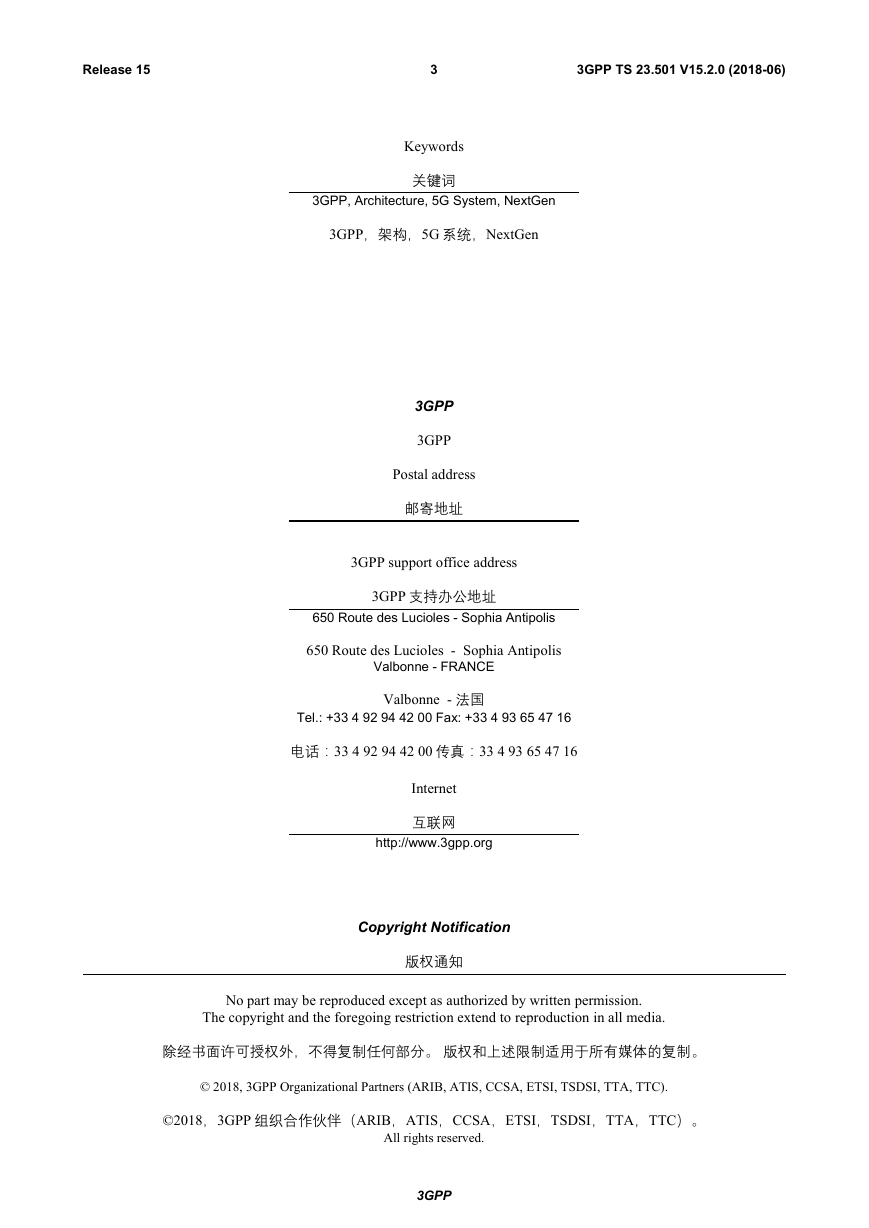
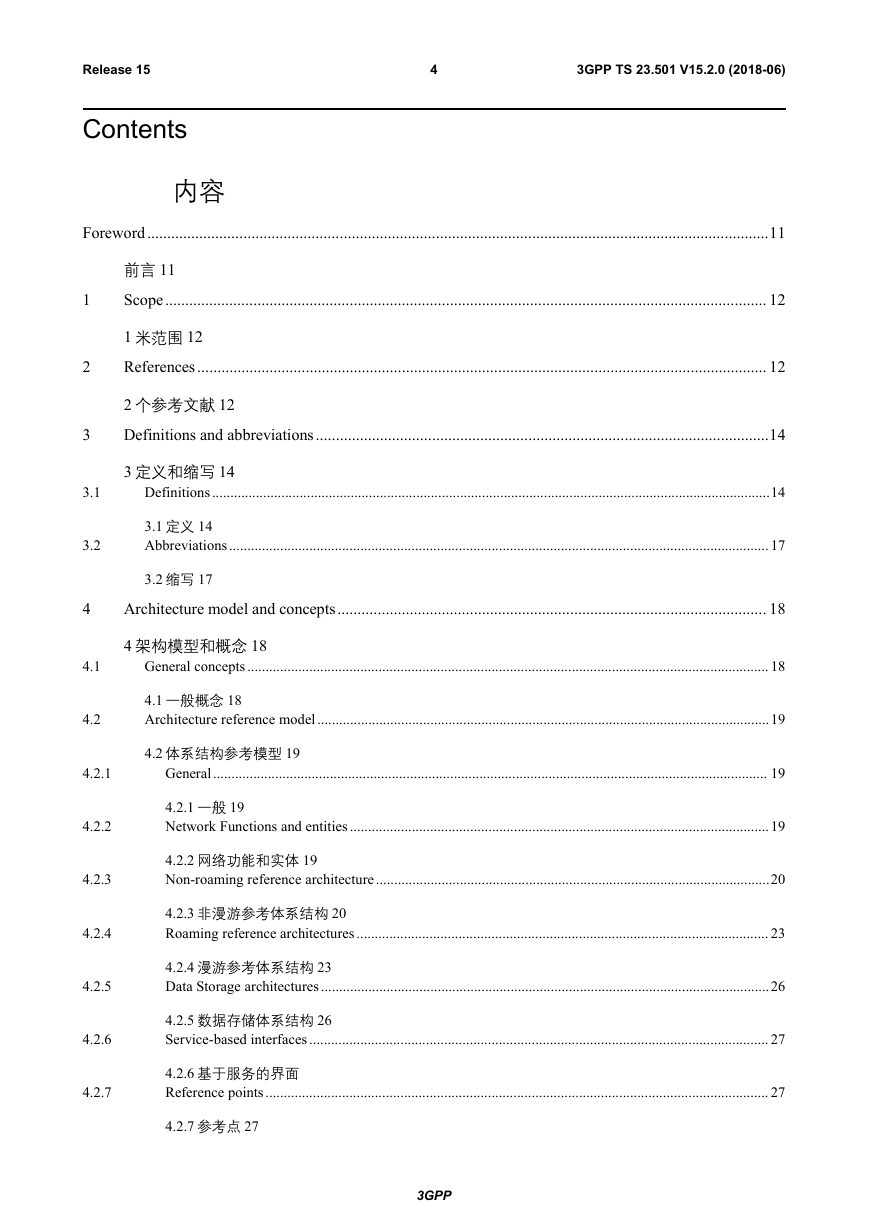
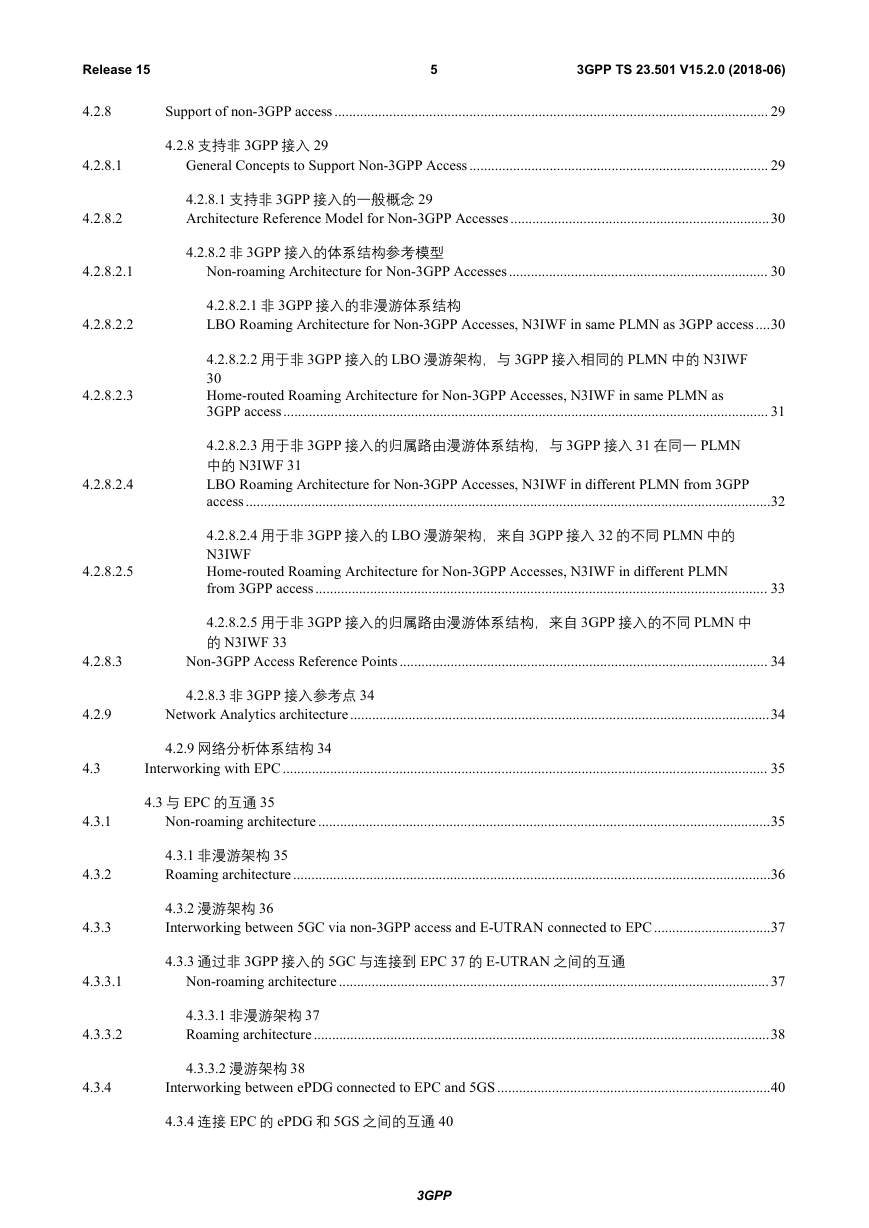
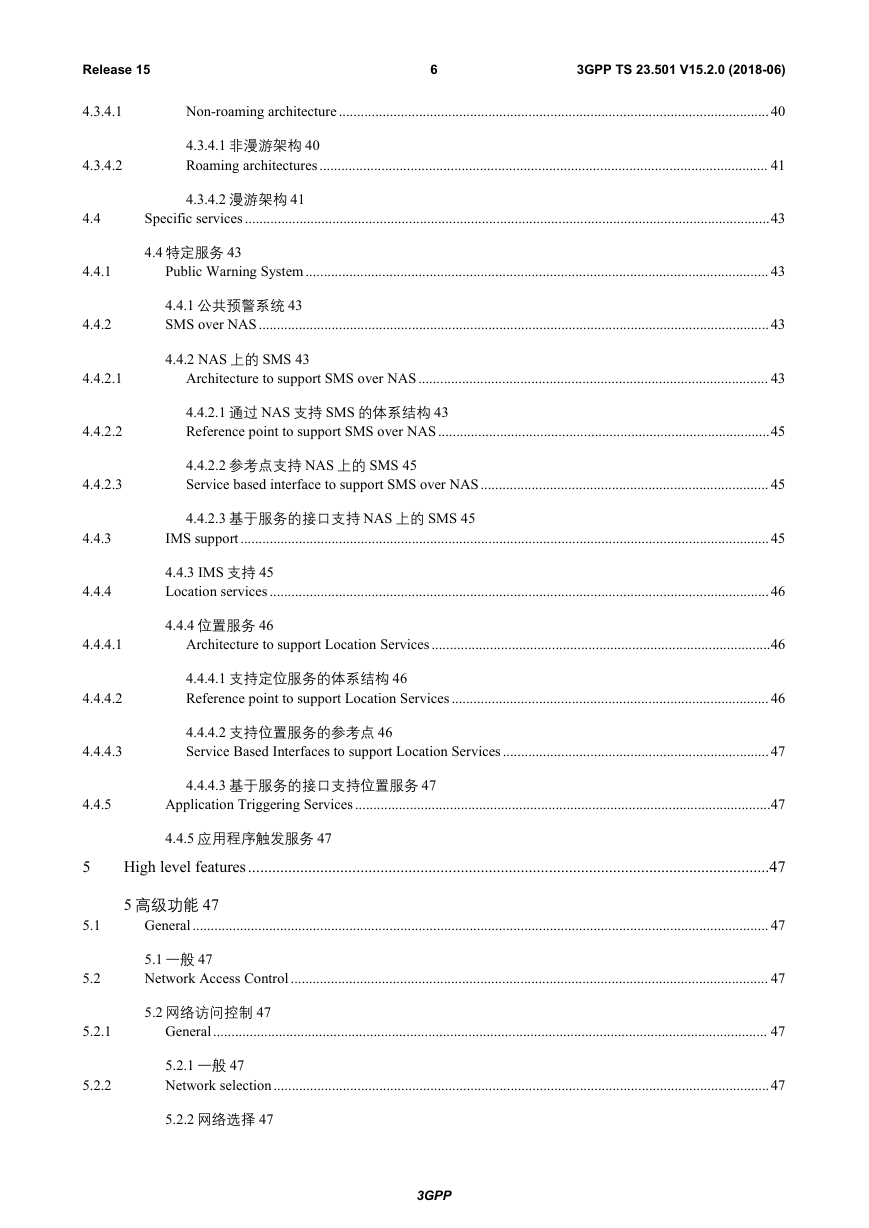
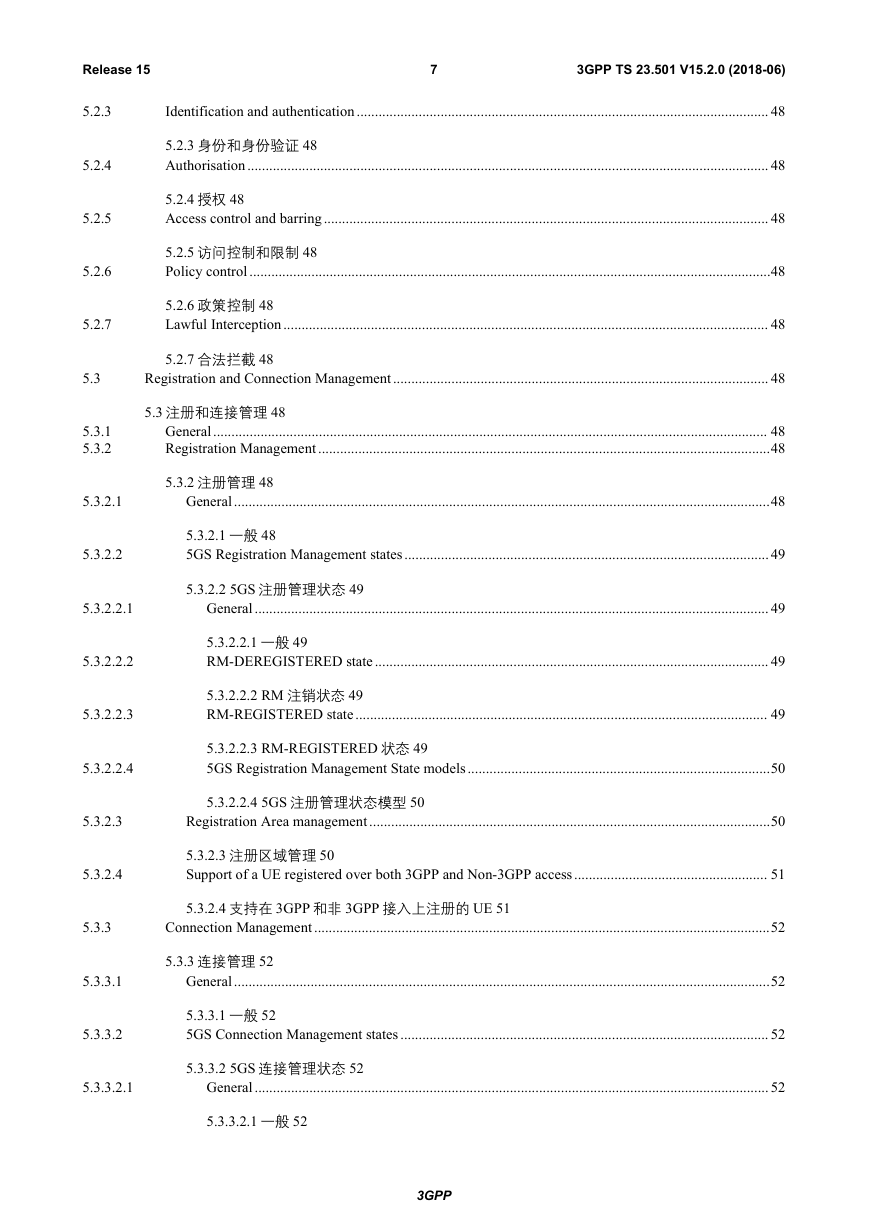
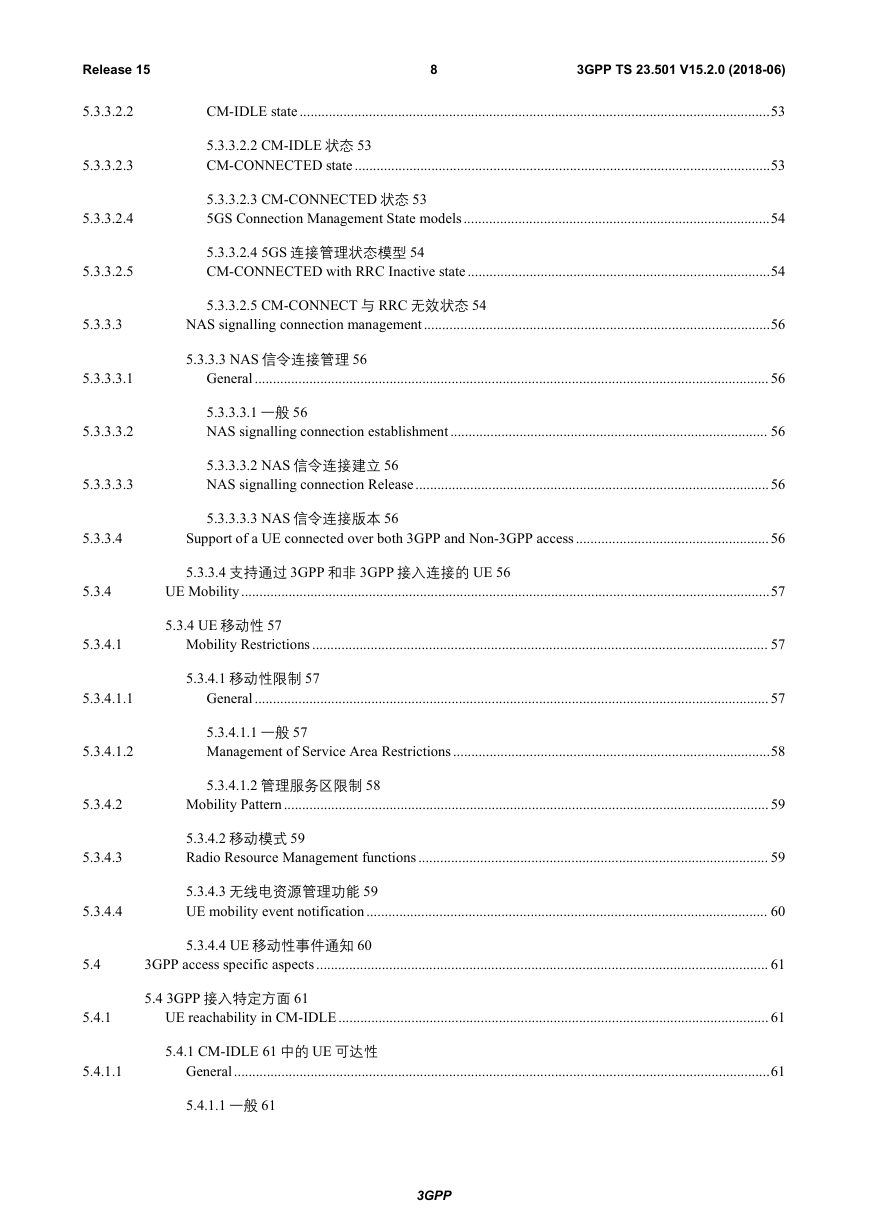








 2023年江西萍乡中考道德与法治真题及答案.doc
2023年江西萍乡中考道德与法治真题及答案.doc 2012年重庆南川中考生物真题及答案.doc
2012年重庆南川中考生物真题及答案.doc 2013年江西师范大学地理学综合及文艺理论基础考研真题.doc
2013年江西师范大学地理学综合及文艺理论基础考研真题.doc 2020年四川甘孜小升初语文真题及答案I卷.doc
2020年四川甘孜小升初语文真题及答案I卷.doc 2020年注册岩土工程师专业基础考试真题及答案.doc
2020年注册岩土工程师专业基础考试真题及答案.doc 2023-2024学年福建省厦门市九年级上学期数学月考试题及答案.doc
2023-2024学年福建省厦门市九年级上学期数学月考试题及答案.doc 2021-2022学年辽宁省沈阳市大东区九年级上学期语文期末试题及答案.doc
2021-2022学年辽宁省沈阳市大东区九年级上学期语文期末试题及答案.doc 2022-2023学年北京东城区初三第一学期物理期末试卷及答案.doc
2022-2023学年北京东城区初三第一学期物理期末试卷及答案.doc 2018上半年江西教师资格初中地理学科知识与教学能力真题及答案.doc
2018上半年江西教师资格初中地理学科知识与教学能力真题及答案.doc 2012年河北国家公务员申论考试真题及答案-省级.doc
2012年河北国家公务员申论考试真题及答案-省级.doc 2020-2021学年江苏省扬州市江都区邵樊片九年级上学期数学第一次质量检测试题及答案.doc
2020-2021学年江苏省扬州市江都区邵樊片九年级上学期数学第一次质量检测试题及答案.doc 2022下半年黑龙江教师资格证中学综合素质真题及答案.doc
2022下半年黑龙江教师资格证中学综合素质真题及答案.doc